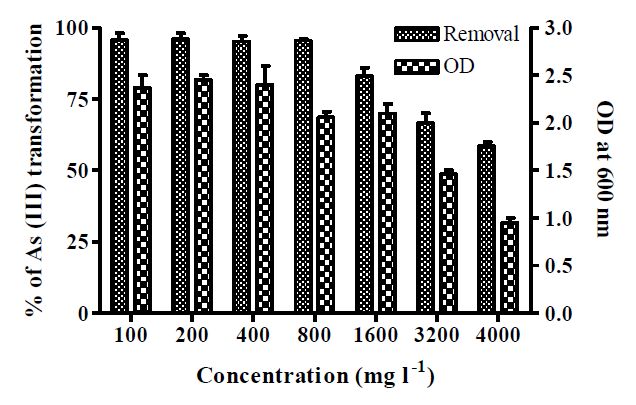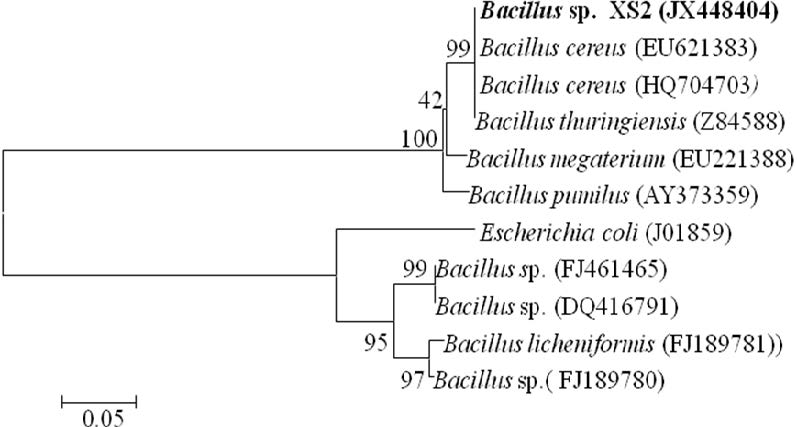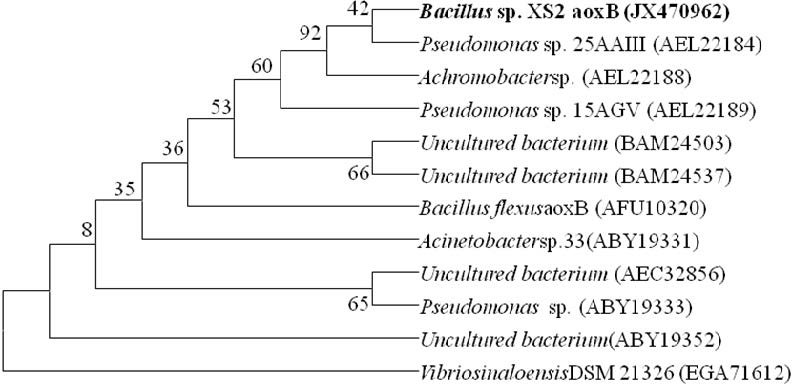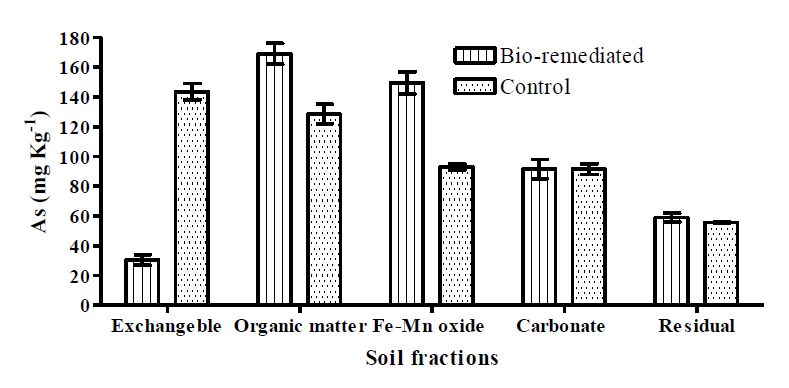1. Introduction
Arsenic (As) is an ill-famed metalloid which exist commonly in two forms As (III) and As (V). Studies have shown that As (III) is more mobile and much more toxic than As (V) [1]. The toxicity of As in soil and water environment is considered, as one of the prominent environmental causes of cancer and many other degenerative diseases in the different part of the world, especially in the countries like Bangladesh, China and India. Chronic exposure to As in different province of China, resulting arsenicosis and it is growing continuously [2]. Groundwater As concentration in Xinjiang, China present in very high concentration about 830 µg L−1 reported by Wen et al. [3] the main reason for As poisoning in this area are both natural and man-made activities, in man-made activities mainly includes, mining activities like coal, uranium, gold mine, etc. which affect at a greater extent. According to World Health Organization (WHO) guideline As in drinking water should not be more than 10 µg L−1 [4]. Recently, Government of China also reduced the As concentration in the water from 50 to 10 µg L−1 consider to be safe limit. Therefore, developing efficient, environment friendly technique to treat As from soil and water system is of great importance. Previously various methods have been developed to treat As contaminated soil and water, based on chemical oxidation, adsorption etc., but this process may release harmful by products as the result of the oxidation process. Bioremediation of toxic metal contaminated site has been often shown to be more efficient than chemical and physical method [5]. Microorganism developed various ways to cope up the As toxicity; some microbes deriving energy by oxidizing As (III) to As (V) whereas other microbes using enzyme arsenic oxidase to oxidize and detoxify the effect of As (III) [6]. Arsenite oxidation generally occurs via the bacterial chromosome with the ars genotype, such as in Alcaligenes faecalis and Pseudomonas putida OS-5 [7]. The potential detoxification processes of As by microorganism may be related to the ars gene or arsenite oxidation gene (aioA) [8]. Arsenic oxidase play critical role in arsenic detoxification processes via the aoxA-aoxB-aoxC-aoxD and aoxS, aoxR or aoxAB systems. Many health issues directly related to the As contamination of soil and water, which include several types cancers especially kidney, lung, bladder, skin etc. and in this region peoples already affected much due to high concentration of As in soil and water. Therefore, this area urgently needed a reliable technique which may be easy to use and which can remediate soil and water efficiently to restore them. Hence, present investigation come-up with a simple, cost effective technique by using an indigenous arsenic oxidizing bacterium isolated from As rich contaminated gold mine tailing having the high transforming ability and observed its potential application to remediate arsenic contaminated soil.
2. Materials and methods
2.1. Isolation, enrichment and screening of As-resistant bacteria
The sample was collected from a gold mine tailing Karamy, Xinjiang China. This sample having As concentration > 200 mg kg−1. Five gram sample was inoculated into a 50 mL of the Erlenmeyer flask containing sucrose minimal salt low phosphate (SLP) medium, which was prepared as follows: Sucrose (1%), (NH4)2SO4 (0.1%), K2HPO4 (0.5%); MgSO4 (0.05%), NaCl (0.01%), yeast extract (0.05%) to enrich bacterial populations. Flasks were incubated at 30°C for 24 h on a rotary shaker for proper oxygen uptake. After incubation enrichment cultures were serially diluted, and a cell suspension was spread onto SLP plates (plates were prepared using 1.5% agar) supplemented with 200 mg L−1 of As (III) to obtain resistant colonies. Different bacterial colonies were obtained and purified by repeated sub culturing on SLP agar medium containing 200 mg L−1 As (III), the purified strain was selected and designated as XS1 to XS12. Further As (III) oxidizing ability tested by using silver nitrate (AgNO3) screening method according to Simeonova et al. [9] and XS2 was used for further investigation and As transformation.
2.2. As transformation
To observe the arsenic transformation/oxidizing ability, XS2 were inoculated into 50 mL of growth medium containing 100, 200, 400, 800, 1600, 3200, 6400 mg L−1 of As (III) and incubated at 30°C with 120 rpm shaking. A control experiment conducted using non-inoculated media with As (III), were also incubated under the same conditions. Inoculated and control sample was taken over, the time for measurements of growth and arsenic transformation. Growth was measured using UV/vis spectrophotometer at a wavelength of 600 nm (UNICO-Shanghai, China 2800). Samples were centrifuged, transferred to separate tube and acidified with concentrated HCl to 1% (v/v), for As analysis. Arsenic transformation was measured at the regular interval of time by continuous flow hydride generation atomic fluorescence spectroscopy (AFS-800, Beijing Titan Instrument Co. Ltd. Beijing, China) as described previously by Glaubig and Goldberg [10] and Voth-Beach and Shrader[11]. Further, it was also confirmed using inductively coupled plasma mass spectrometry (ICP-MS) (ELANDRC-II, Perkin Elmer).
2.3. Enzyme assay for arsenic oxidation
To determine arsenic oxidase activity, sphaeroplast was prepared as protocol described by Anderson et al. [12]. XS2 was cultured in the presence of arsenite (1 mM or 100 mg/L); centrifuged and recovered cells were added in 20 mM Tris-HCl, 0.1 mM PMSF, (phenyl methane sulfonyl fluoride) 10 mM EDTA pH 8.4 containing 20% sucrose. Further treatment with lysozyme 0.5mgmL−1 for 40 minutes at 25°C was performed. The arsenic oxidase activity assay was based on a reduction of 2, 6-dichlorophenolindophenol (DCIP) in MES (Morpholino ethelenediol sulfonic acid) buffer at pH 6.0. Kinetic value was determined by the addition of the enzyme into 1 mL of assay buffer containing 60 µM DCIP, 200 µM of NaAsO2 and 50 mM MES at pH 6.0. Change in absorbency min−1 was monitored at 600 nm for a period of 5 min. Heat denatured protein served as a control for this experiment. Specific activity was defined as micro moles of DCIP reduced per minute per milligram of protein.
2.4. Amplification of aioA-gene/aoxB gene and 16s rRNA gene
Whole genomic was isolated from full-grown culture by the simple lysis protocol as described by Kapley et al. [13]. The isolated DNA was observed by gel-electrophoresis and further used polymerase chain reaction (PCR) as a template DNA. The PCR amplification of both 16S rRNA and aioA-gene were carried out in a 100 µL reaction mixture containing 100 ng DNA as template, Sequence of the PCR primer for aioA-gene were (Forward primer 5’GTSGGBTGYGGMTAYCABGYCTA3’Reverse primer 5’TTGTASGCBGGNCGRTTRTGRAT’) as described by Inskeep et al. [14]. The PCR programme includes cycling program denaturation (94°C, 1 min), annealing (49°C, 1 min) and extension (72°C, 2 min). Initial denaturation (94°C, 2 min) and final extension (72°C, 5 min) were performed at the end of the 35 cycles. 16S rRNA gene was amplified according to Weisberg et al. [15]. The reaction mixture for the PCR contained 1X PCR buffer; 200 µM of dNTPs; 1.5 mM MgCl2, 0.1 µM of each primer and 2.5 units of Taq DNA polymerase (Nitrogen, USA) in a final volume of 100 µl sterile MQ waters. The PCR was performed with an initial denaturation at 92°C for 2 min followed by 36 cycles at 92°C for 1 min, 48°C for 30 s and 72°C for 2 min and a final extension of 72°C for 6 min. All PCR amplifications were performed using MG25+LongGene PCR systems (Scientific institute co. Ltd, China). The amplified DNA was purified by Mini BEST DNA Fragment Purification kit (Takara, Japan) and ligated into the pGEM-T easy vector (Promega Inc., USA). Ligated plasmid was transformed into DH5α cells (E. coli) by calcium chloride treatment and heat shock method. After a screening of the positive clones, plasmid DNA was extracted using a plasmid extraction kit (Takara, Japan). Finally, the clones were sequenced using the T7 and SP6 primers from the vector.
2.5. Sequencing and phylogenetic analysis
DNA sequencing analysis was performed using an Applied Ecosystems (ABI Prism 3730 DNA analyzer) sequencer (DNA sequencing facility, Beijing Genomics Institute, Beijing, China). The initial sequence analysis was done using BlastN/RDPII (for 16S rRNA gene) and BlastN/BlastX (for aioA/aoxB gene) to deduce amino acid sequences from nucleotide database query program. Phylogenetic analyses were carried out with MEGA 5.0 using a neighbour-joining method [16]. The 16S rRNA gene sequence and aoxB gene sequence were submitted to GenBank under accession number JX448404 and JX470962.
2.6. In-situ remediation
Bioremediation ability of XS2 was performed in a glass beaker containing 200 grams of As contaminated dried, sterilized soil sample with 500 mg kg−1 of As (III) and 400 mL of overnight grown XS2 (107 cfu mL−1) in SLP medium. Control studies were also conducted in a similar way without the addition of bacterial cells. The beaker was incubated at 30°C for two weeks. As was extracted from different fractions of the soil, using Tessier sequential extraction procedure [17]. Different faction was obtained are described like: exchangeable, carbonate bound, Fe-Mn bound, organic matter bound and residual fraction. Arsenic was analyzed from different fraction using the hydride generation atomic flame spectrometer (AFS) and ICP-MS.
2.7. Data analysis
Data were statistically analyzed by analysis of variance (ANOVA) and the mean differences were compared by Tukey-Kramer Multiple Comparison Test at p < 0.05. All the experiment was conducted with three replicates and the analyses were performed using GraphPad Prism (v 4.03) software.
3. Results
3.1. Screening and selection of arsenic oxidizing bacteria
A total of twelve morphological different isolates were obtained with 200 mg L−1 of arsenic amended SLP plates. Subsequent microscopic observation and restriction enzyme digestion (BamH1and EcoR1) of amplified 16S rRNA gene, suggested that some of these isolates were likely to same, so five apparently different isolate were chosen for the As-resistance experiment, XS2 is among one of them having high tolerance and high transforming ability.
3.2. Effect of As (III) on growth and transformation
Resistance of XS2 was assessed at high concentration under aerobic growth condition. XS2 was resistant to As (III) and exhibited minimum inhibitory concentration up to 6400 mg L−1. No growth was observed above this concentration. XS2 grow well at high concentration of arsenic, but successfully oxidize up to 4000 mg L−1. Within 6 h of incubation XS2 achieved absorbance approximately 0.4 which shows that this strain can utilize arsenic easily and maximum growth was achieved at 48 h of incubation period, at 96 h XS2 attained stationary phase (Figure 1). The growth XS2 was not significantly affected at 3200 mg L−1, but at higher concentration 4000 mg L−1 the growth initially slow further the bacterium experienced normal growth even with the influence of high arsenic level. XS2 was able to oxidize 95% at 800 mg L−1 and 82% at 1600 mg L−1. But an increase in concentration affect the oxidizing ability at 3200 mg L−1. XS2 oxidized approximately 66% and at 4000 mg L−1 oxidized up to 57%, which shows that higher concentration gradually affects the oxidizing ability of Bacillus sp. XS2 (Figure 2).
3.3. Determination of arsenic oxidase
Bacterial strain XS2 has shown good activity for arsenic oxidase enzyme which was observed in the periplasmic released and in spheroplast. No arsenite oxidase was observed in the culture supernatant. During sphaeroplast preparation about 10% activity was only found in the periplasmic released and 90% activity was present in the sphaeroplast/membrane fraction, which showed that a major portion of arsenic oxidase was associated with spheroplast. Further specific activity was determined and found in both fractions. About 0.012 µM min−1 mg−1 protein observed in periplasmic released and 0.10 µM min−1 mg−1 protein in sphaeroplast.
3.4. Identification of arsenic oxidizing bacterium
16S rRNA gene sequence data of the isolate was analyzed by Blast search. The BlastN analysis of this sequence showed 99% of sequence identity with Bacillus cereus (EU621383). A phylogenetic tree was constructed based on 16S rRNA gene sequence by a NJ-method using MEGA software (v5.0). The phylogenetic analysis revealed that XS2 was grouped with Bacillus cereus. And hence designated it as Bacillus sp. XS2 (Figure 3).
3.5. Detection of aioA/aoxB gene
The presence of a genetic basis for As resistance and As transformation in XS2 was examined by PCR amplification of As marker gene, and the PCR product was further sequenced to confirm detection of the target gene. Isolated bacterial strain XS2 was found to be positive for the aioA/aoxB gene. The aoxB gene sequence of XS2 showing close similarity with different previous reported genera like Bacillus sp. (accession No. HQ994648) Pseudomonas sp. (accession No. HQ449647) and Achromobacter sp. (accession No. HQ449654) isolated from As contaminated sediments. Further BlastX was used to deduce the amino acid sequence of NCBI database. Phylogenetic relationships were obtained by comparing the deduced amino acid sequences of the 11 bacterial isolates with a sequence of previously reported As-resistant, As(III)-oxidizing bacteria and closely related bacterial isolates containing arsenic oxidase Mo-pterin larger subunit. The deduced amino acid sequence from aoxB gene showed 42% identified with the large subunit with Pseudomonas sp. (AEL22184) shown in (Figure 4).
3.6. In-situ remediation (by Bacillus sp.)
XS2 played an important role in transforming As (III) in soluble exchangeable fraction. In treated soil sample Bacillus sp. transformed about 81%, significantly lowered the exchangeable fraction (left about 30.5 mg kg−1) while untreated sample having a very high value of As (III) approximately 143.52 mg kg−1 (Figure 5). Further concentration of As in treating sample was observed highest in organic matter bound > Fe-Mn bound > carbonate bound > residual and least in exchangeable fractions. Whereas untreated sample having highest in exchangeable > organic matter bound > Fe-Mn bound > carbonate bound > residual. Bio-remediated soil sample significantly lowered in exchangeable fractions. The exchangeable fraction gets release easily into the soil due to ion exchange and bio-available. No significant changes were observed in carbonate and residual fraction. The viability of bacterial cells in a soil sample was determined after 7 d in terms of colony forming unit we observed 5×107 cells mg−1 of soil, which showed that the viability of cells were maintained well in the soil sample and transformed As (III) successfully.
4. Discussion
Human activities are continuously increasing in every area and contaminating the large part of the atmosphere. Pollution of soil and water is a major environmental concern, therefore it is a need to search an alternative method to resolve these problems. As is a persistent pollutant which cannot be easily degraded and cleaned, only it can be transformed from toxic to less toxic one. In the present investigation the relevant As (III)-oxidizing bacteria that existed with highly As-contaminated mine tailings area of Xinjiang, China (As concentration 200 mg kg−1). Present isolates XS2 were able to transform arsenic at higher concentration up to 4000 mg L−1 in shorter period than any of the previous reported Bacillus sp. XS2 grows well in the different concentration of arsenic tested in the present study and transformed sufficiently. Previously Battaglia-Brunet et al. [18] observed oxidation of As (III) by a strain CASO1 with 1000 mg L−1. Weeger et al. [19] isolated heterotrophic bacterial strain ULPAs1 from an aquatic environment contaminated with As and efficiently transformed/oxidizes As (III) up to 500 mg L−1. Previously Chang and Kim [20] found that Bacillus sp. having a high tolerance to sodium arsenite up to 50 mM and able to transform/oxidize successfully up to 1 mM concentration, which is an agreement that Bacillus sp. is capable to oxidize arsenic. As (III) oxidation has also been identified by different bacterial isolates like Alcaligenes [21], Agrobacterium [22], Thermus [23] and Commons terrae [24] isolated from different environments. Comparing to previous other isolates, XS2 has shown high resistance and efficient oxidizing ability at high concentration. According to Pepi et al. [25] found Pseudomonas and Bacillus sp. are broadly represented among As-resistant bacterial strains isolated from other As-contaminated sites. Further, the bacterium was identified using 16s rRNA gene sequence analysis, which shown maximum identity with Bacillus sp. in GeneBank database. Present isolate XS2 probably use As (III) oxidation as a detoxification mechanism. Basically arsenic oxidation was catalyzed by an arsenic oxidase. These consist of two different sub unitone small Fe-S Rieske subunit coded by gene aoxA/aroB and other larger Mo-pterin subunit coded by aoxB/aroA/asoA gene [26]. Arsenic oxidase providing resistance, detoxification and energy generation at high concentration of As (III). Generally arsenic oxidase enzyme found either membrane bound or in the periplasmic space of the bacterial cells. Present isolates had also shown arsenic oxidase activity which may favors to bacteria at high concentrations of arsenic. From the present study, we observed arsenic oxidase a membrane bound protein in both supernatants and in pellate. Which support the bacteria to metabolize arsenic at high concentration. This is supported by the work of Prasad et al. [27] found arsenic oxidase activity from a gram positive Arthrobacter sp.. Ellis et al. [28] resolved the structure of the arsenic oxidase it consists of two major subunits. The large subunit, an 88-kDa polypeptide (825 amino acids residues) contains the Mo-pterin and HiPIP (High potential Iron Protein) 3Fe-4S center, whereas, the small subunit, a 14-kDa (134 amino acids) consists of the Rieske 2Fe-2S center. The aioA/aoxB gene was also found in XS2 and proved as arsenic oxidizers. This indicates that aoxB may be specific for most of the aerobic arsenic oxidizing bacteria. Srivastava et al. [29] found As resistance genes in Staphylococcus sp. NBRIEAG-8 which able to grow on 1500 mg L−1 of As (III). Instep et al. [14] reported that the expression level of aioA/aoxB gene could probably be applied to monitor environmental As-contaminated levels.
A phylogenetic analysis of the 11 arsenic oxidizers based on deduced amino acid sequences of the aoxB gene showed a similar phylogeny indicating gnomic stability of the aoxB gene. From phylogeny shows maximum similarity with Pseudomonas sp. XS2 efficiently transformed soluble As (III) from the soil and reduced its mobility to release into the soil, which is of great importance at this concentration because As (III) is readily bioavialable and easily contaminate the food and water. As was observed in the different fraction of soil in bioremediated sample there was increased As concentration was observed in organic matter bound and Fe-Mn bound as compare to control which prevent the mobile As and make them stable, simultaneously a significant decrease in the exchangeable fraction showing the potential of the present work. As content increased in organic bound fractions may be due to biomass formation because XS2 grown well into the soil shown in results, played a significant role in preventing the mobility. Present result supported by the previous finding of Kirkham [30] organic matter plays an important role in forming complexes in the soil; like Fe-Mn bound is tightly associated with the soil so this fraction is not easily released. According to Manning et al. [31], As tends to bind more strongly with ferric hydroxide in the soil and more stable in nature, here also bioremediated sample having increased As concentration in Fe-Mn bound. As content in residual fraction is also tightly bound with the trace metals which are not expected to release under natural condition [32]. Increased As level will result in new selective pressure for As resistance, and an increased importance of examining microbial As resistance in natural environments. Finally, this work brings an efficient arsenic transforming microbe at very high concentration and shown the molecular basis of resistance. Further, this bacterium was applied and observed for successful bio remediation of As contaminated soil.
5. Conclusion
Present results come up with a strain having high tolerance, the high transforming ability of arsenic species in the short period at both laboratory and in the soil and shown good survival in soil during bioremediation experiment. The results clearly state that Bacillus sp. XS2 significantly reduced the exchangeable or bio-available form of arsenic from the soil, this ability of the present strain kept into the row of a prospective microbe for the site contaminated with arsenic in the environment.
Acknowledgement
This work was supported by Chinese Academy of Sciences Fellowships for Young International Scientists (No. 2011Y2ZB06) and Program of 100 Distinguished Young Scientists of the Chinese Academy of Sciences and National Natural Science Foundation of China (U1120302 and 21177127).
Conflict of interest
The authors have declared no conflict of interest.









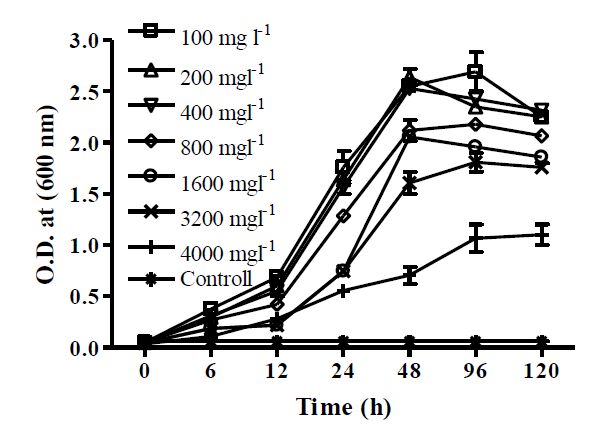
 DownLoad:
DownLoad: 